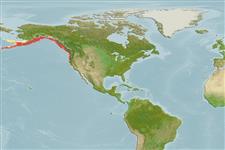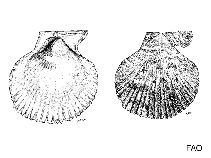Patinopecten caurinus (Gould, 1850)
Giant Pacific sea scallop| Native range | All suitable habitat | Point map | Year 2050 |

|
| This map was computer-generated and has not yet been reviewed. |
| Patinopecten caurinus AquaMaps Data sources: GBIF OBIS |
Google image | No image available for this species;
drawing shows typical species in Pectinidae.
Classification / Names Populärnamn | synonymer | CoL | ITIS | WoRMS
Bivalvia | Pectinida | Pectinidae
Environment: milieu / climate zone / djupintervall / distribution range Ekologi
; djupintervall 2 - 300 m (Ref. 114301), usually 60 - 120 m (Ref. 114306). Temperate, preferred 7°C (Ref. 107945); 64°N - 36°N, 179°W - 120°W
Distribution Länder | FAO områden | Ekosystem | Förekomster | Utplanteringar
Eastern Pacific: From Pribilof Islands, Alaska to Point Sur, California, USA. Temperate to boreal.
Length at first maturity / Size / Weight / Age
Könsmognad: Lm ? range ? - ? cm Max length : 28.0 cm SHL hane/ej könsbestämd; (Ref. 95344); rapporterad maxålder: 15 år (Ref. 8702)
Life cycle and mating behavior Könsmognad | Reproduktion | Lek | Eggs | Fecundity | Larvae
Main reference
referenser | Koordinator | Medarbetare
Ignell, S. and E. Haynes 2000 Geographic patterns in growth of the giant Pacific sea scallop, Patinopecten caurinus. Fish. Bull. 98:849-853. (Ref. 386)
IUCN Red List Status
(Ref. 130435: Version 2025-1)
CITES status (Ref. 108899)
CMS (Ref. 116361)
Threat to humans
Human uses
Fiskeri: kommersiell
FAO - fiskeri: landings | FishSource | Sea Around Us
Verktyg
Ytterligare information
Max. ages / sizes
Length-weight rel.
Length-length rel.
Length-frequencies
Mass conversion
Abundans
Internet-källor
BHL | BOLD Systems | CISTI | DiscoverLife | FAO(fiskeri: ; publication : search) | Fishipedia | GenBank (genome, nucleotide) | GloBI | Gomexsi | Google Books | Google Scholar | Google | PubMed | Tree of Life | Wikipedia (Go, sök) | Zoological Record



